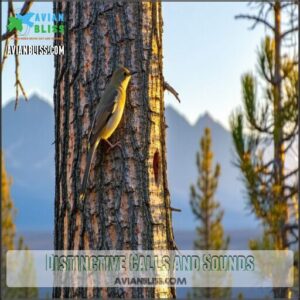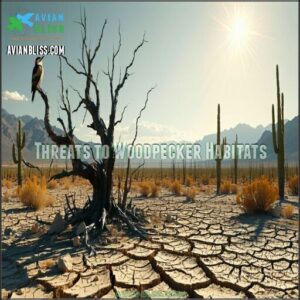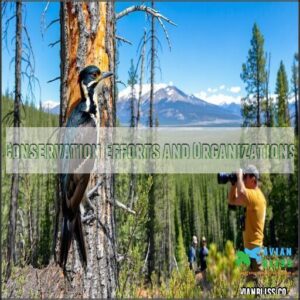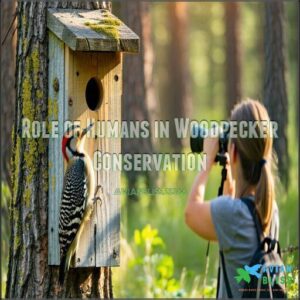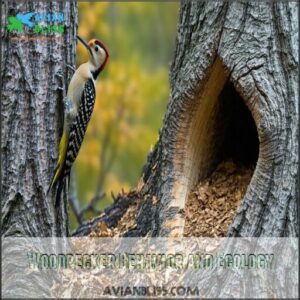This site is supported by our readers. We may earn a commission, at no cost to you, if you purchase through links.
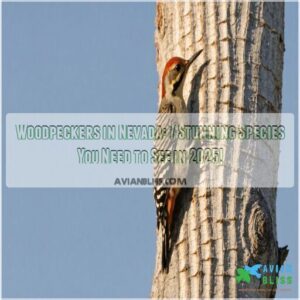 You’ll find seven woodpecker species in Nevada, each adapted to the state’s diverse habitats.
You’ll find seven woodpecker species in Nevada, each adapted to the state’s diverse habitats.
The most common woodpeckers in Nevada include the Northern Flicker, Hairy Woodpecker, and Ladder-backed Woodpecker.
These remarkable birds have specialized skulls that absorb shock while they drum on trees at force levels that would concuss humans.
In Nevada’s deserts, woodpeckers often nest in Joshua trees and cacti instead of traditional forests.
You’ll hear their distinctive drumming echoing through pine forests in the Spring Mountains or along riparian corridors near Lake Tahoe.
Their remarkable ability to thrive in Nevada’s harsh landscapes reveals nature’s ingenious adaptations.
Table Of Contents
- Key Takeaways
- Woodpeckers in Nevada
- Woodpecker Species Overview
- Woodpecker Habitat and Distribution
- Woodpecker Behavior and Ecology
- Woodpecker Conservation and Safety
- Frequently Asked Questions (FAQs)
- Does Nevada have woodpeckers?
- Do woodpeckers live in Nevada?
- Are there woodpeckers in Las Vegas?
- Where do woodpeckers live?
- What are the different types of woodpeckers?
- Where do acorn woodpeckers live?
- What is a pileated woodpecker?
- Is it good to have woodpeckers in your yard?
- Is it rare to see a woodpecker?
- Do we have woodpeckers in Nevada?
- Conclusion
Key Takeaways
- You’ll find seven woodpecker species in Nevada, each adapted to different habitats ranging from northern coniferous forests to southern desert landscapes with Joshua trees and cacti.
- Northern Flickers are the most widespread species in Nevada, while other notable species include Hairy Woodpeckers, Downy Woodpeckers, and Ladder-backed Woodpeckers.
- These birds have specialized skulls that absorb shock while drumming on trees, and they create cavity nests that provide homes for over 40 other wildlife species.
- Climate change and habitat loss pose significant threats to Nevada’s woodpeckers, but you can help through conservation efforts like installing nest boxes and supporting responsible forestry practices.
Woodpeckers in Nevada

You’ll find over 15 species of woodpeckers throughout Nevada’s diverse landscapes, from the Northern Flicker in both urban Reno and remote Great Basin National Park to the striking Lewis’s Woodpecker with its distinctive green-black plumage and pink belly.
These remarkable birds adapt to specific habitats across the state, with species like the Downy Woodpecker frequenting northern regions while the Acorn Woodpecker primarily inhabits the southern mountainous areas, showcasing their ability to thrive in various landscapes.
Northern Nevada Woodpeckers
Five striking woodpecker species make Northern Nevada their home.
You’ll spot the Northern Flicker with its distinctive brown plumage and black chest crescent throughout the region.
Downy Habitats typically include wooded areas near Reno, while their larger cousin, the Hairy Woodpecker, prefers the dense forests of Humboldt-Toiyabe.
Don’t miss Lewis’s Behavior—they catch insects mid-air unlike other Nevada woodpeckers.
The rare American Three-toed Woodpecker showcases impressive adaptations for Nevada’s northern coniferous forests.
Some species face habitat loss challenges.
Central and Mountainous Nevada Woodpeckers
When hiking through Nevada’s mountainous regions, you’ll discover a treasure trove of woodpecker species uniquely adapted to high-altitude environments.
The central mountains host five remarkable woodpeckers: Lewis’s Woodpecker with its distinctive pink belly, the Williamson’s and Red-naped Sapsuckers showing striking red patches, White-headed Woodpeckers easily identified by their contrasting coloration, and Red-breasted Sapsuckers that depend heavily on Sierra Nevada forest habitats for survival.
These species face increasing climate impacts, making habitat conservation critical, which is essential for the survival of these unique birds in their high-altitude environments.
Southern Nevada Woodpeckers
While the mountainous regions have their woodpecker specialists, the Mojave Desert species have adapted to southern Nevada’s unique landscapes.
You’ll discover fascinating woodpeckers around Las Vegas and Red Rock Canyon:
- Acorn Woodpeckers store thousands of acorns in their "granary trees"
- Gilded Flickers frequently forage on the ground for ants
- Gila Woodpeckers showcase remarkable urban adaptation, sometimes nesting near residential areas
These Nevada birds add vibrant life and distinctive calls to the southern Nevada wildlife community, making them a notable part of the unique landscapes.
Rare and Occasional Nevada Woodpeckers
While southern Nevada offers its own woodpecker species, you might be lucky enough to spot some rare visitors throughout the state.
The massive Pileated Woodpecker makes occasional appearances near Lake Tahoe, while Yellow-bellied rarity increases in northeastern regions around Ruby Mountains.
Red-headed decline hasn’t stopped sporadic sightings, and Ladder-backed habitat remains limited to northern forests.
The Gila distribution focuses in Mojave areas, making Nevada birding hotspots perfect for woodpecker enthusiasts hunting uncommon species.
Woodpecker Species Overview
Nevada’s woodpeckers display remarkable diversity with their specialized beaks, distinctive plumage patterns, and unique drumming sounds that you’ll easily recognize after your first encounter.
You’ll find these fascinating birds throughout the state’s varied habitats, from the Northern Flicker’s spotted breast and loud calls in urban parks to the rare Black-backed Woodpecker’s striking appearance in fire-damaged forests, showcasing their ability to thrive in different environments with their unique drumming sounds.
Physical Characteristics
You’ll notice distinctive plumage coloration across Nevada’s woodpecker species.
Most display sharp black-and-white patterns, while others showcase vibrant red patches or unique yellow accents.
Beak morphology varies substantially – from the Hairy Woodpecker’s long, chisel-like bill to the Northern Flicker’s slightly curved one.
Size variation ranges from the small Downy (6 inches) to the larger Lewis’s (10 inches).
Sexual dimorphism often appears as red patches on males, making woodpecker identification straightforward once you know what to look for, and understand the importance of distinctive plumage and beak morphology.
Behavioral Traits
Those beautiful woodpeckers aren’t just pretty faces! Beyond their striking physical features, Nevada’s woodpeckers display fascinating behavioral traits that make them truly enchanting to observe.
You’ll find these behaviors particularly interesting:
- Drumming Communication – They create unique rhythmic patterns to establish territory
- Foraging Strategies – Different species employ specialized techniques for finding food
- Social Hierarchy – Woodpeckers maintain complex family structures
- Territory Defense – They actively protect their nesting and feeding areas
- Acrobatic Movement – Watch them climb vertically and hang upside-down with ease
Nesting and Breeding Habits
Most Nevada woodpeckers demonstrate cavity nesting behavior, excavating holes in dead trees or cacti.
You’ll find their clutch size typically ranges from 3-8 eggs, with an incubation period of 11-14 days.
Both parents share chick development responsibilities, taking turns feeding their young.
Woodpecker breeding success in Nevada depends largely on habitat availability, with fledgling success rates higher in undisturbed forests.
Their nesting chambers are engineering marvels—warm in winter, cool in summer, and they optimize nesting locations based on shelter and safety.
Distinctive Calls and Sounds
Woodpeckers’ distinctive calls and sounds serve as their acoustic signatures in Nevada’s diverse habitats.
You’ll recognize these birds not just by sight but by their unique vocalizations.
- Northern Flickers announce themselves with a loud "wicka-wicka-wicka" call
- Sapsucker drumming creates a distinctive slow, rhythmic pattern
- Call variations between species help with identifying species even before spotting them
- Sound function includes territory marking, finding mates, and communication
Woodpecker Habitat and Distribution
You’ll find Nevada’s woodpeckers distributed across distinct ecological zones, from the northern coniferous forests where Downy and Hairy Woodpeckers thrive to the southern desert regions where Gilded Flickers and Acorn Woodpeckers have adapted to harsh conditions.
Each species has established specialized habitats in response to Nevada’s diverse landscapes, with some like the Northern Flicker occupying multiple regions while others like the Black-backed Woodpecker specifically seek out recently burned forest areas.
The woodpeckers’ ability to adapt to different environments is a key factor in their survival, and understanding their ecological zones is crucial for conservation efforts.
Importance of Forests and Woodlands
Forests and woodlands serve as lifelines for Nevada’s woodpeckers.
You’ll find these birds thriving where trees provide both food and shelter.
Their specialized beaks tap into bark, hunting insects hidden within.
Without forested areas, Nevada ecosystems would lose these natural pest controllers.
Climate change impacts these woodpecker habitats directly, making conservation of our remaining woodland corridors more urgent than ever, as they are crucial for the ecosystems and require immediate conservation.
Threats to Woodpecker Habitats
Dangers lurk for woodpecker habitat across Nevada as climate change intensifies.
Large-scale wildfires now transform forests into shrublands, disrupting the ideal habitat mosaic woodpeckers need.
You’ll notice these critical threats affecting their survival:
- Climate change creates hotter conditions accelerating habitat loss
- Intense wildfires eliminate the patchwork landscapes woodpeckers need for breeding
- Invasive plant species outcompete native vegetation after fires
- Human development fragments remaining forest areas
- Post-fire landscape shifts reduce suitable nesting sites for woodpeckers
Many species face habitat loss and human impact due to habitat loss and human development, which are exacerbated by intense wildfires and invasive plant species.
Conservation Efforts and Organizations
While habitats face threats, several organizations work tirelessly on woodpecker conservation in Nevada.
Sierra Forest Legacy hosts watershed restoration workshops while Conservation Biology Institute develops decision-support maps for habitat preservation.
These efforts focus on maintaining dead trees and preventing clear-cutting of old-growth forests.
Organizations collaborate with federal agencies on fire mitigation strategies that benefit species like the Black-backed Woodpecker, which relies on burned forests.
You can find woodpecker habitat products online.
Your support through citizen science helps secure funding sources for ongoing woodpecker protection.
Role of Humans in Woodpecker Conservation
You can make a significant difference in woodpecker conservation in Nevada through simple actions.
Climate change and habitat loss threaten these important birds, but your help matters.
Here’s how to contribute:
- Install nest boxes in your yard
- Support responsible forestry practices
- Participate in local birdwatching initiatives
- Join education outreach programs
- Advocate for habitat preservation policies
Every effort helps protect these remarkable birds.
Woodpecker Behavior and Ecology
You’ll witness Nevada’s woodpeckers creating essential forest habitats through their unique behaviors, from the Northern Flicker’s ground-foraging for ants to Lewis’s Woodpecker’s flycatcher-like aerial hunting technique.
When you observe these remarkable birds, you’ll notice their specialized roles in the ecosystem, including their cavity-creation that provides homes for over 40 other wildlife species.
Their essential work controlling insect populations throughout the state’s diverse landscapes is also crucial, highlighting the importance of these birds in maintaining the balance of Nevada’s ecosystems, and demonstrating their cavity-creation provides vital support.
Mating and Breeding Habits
Many Nevada woodpeckers begin courtship rituals in early spring with drumming and display flights.
You’ll notice males excavating nest cavities in dead trees to attract females.
After pairing, females lay 3-7 white eggs and share egg incubation duties with males.
Chick development takes about 24-28 days, with both parents providing careful parental care until fledging.
Woodpecker breeding success depends on suitable woodpecker habitats in Nevada.
Foraging and Feeding Behaviors
While woodpeckers’ romantic lives are fascinating, their dining habits are equally impressive.
You’ll find Nevada’s woodpeckers using specialized diets and unique techniques to find food.
Northern Flickers often practice ground foraging, hunting ants in soil. Sapsuckers drill neat rows of holes for sap-feeding, while others hammer into bark for insect consumption.
Some species even create "larders" for food storage, wedging nuts into tree crevices for later meals.
Social Interactions and Communication
Beyond food gathering, Nevada’s woodpeckers engage in complex social interactions and communication. You’ll often hear them before seeing them.
These master communicators use various sounds and behaviors to interact with each other:
- Drumming on resonant surfaces announces territory and attracts mates
- Distinctive calls ranging from the Northern Flicker’s "wicka-wicka-wicka" to softer contact notes
- Visual displays including head bobbing, wing spreading, and crest raising
- Ritualized flight patterns during courtship
- Cooperative breeding where older offspring help parents raise new broods
Migration Patterns and Wintering Grounds
While some Nevada woodpeckers stay year-round, others follow seasonal migration triggers.
The Northern Flicker shows distinctive migration patterns, with western red-shafted variants moving from mountains into Nevada’s lowlands during winter.
You’ll notice Lewis’s Woodpeckers making short-distance movements between wintering habitats and breeding grounds, forming small wandering flocks when food searching.
Nevada serves as an important stopover territory for these migratory birds, whose ranges shift with climate impact and resource availability.
Woodpecker Conservation and Safety
You’ll find Nevada’s woodpeckers facing several threats including habitat loss and human-wildlife conflicts, but there’s hope through specialized rehabilitation centers and conservation programs dedicated to these remarkable birds.
When you spot an injured woodpecker, it’s essential to contact wildlife authorities immediately rather than attempting to handle the bird yourself, as proper care requires specialized knowledge of their unique anatomy and needs.
Common Health Issues in Woodpeckers
While observing woodpeckers’ fascinating behaviors, you should also watch for health issues affecting these Nevada birds.
Histoplasmosis, a respiratory disease, is most common in woodpeckers. They can also suffer from Haemoproteus velans infections, fungal infections like candidiasis, and avian pox that causes wart-like growths.
These birds may contract West Nile virus or experience feather loss from various conditions. Lead poisoning can occur when woodpeckers ingest contaminated materials in their habitat, affecting woodpecker conservation efforts.
Respiratory infections can arise from poor ventilation issues, so monitoring their environment is important.
Injuries and Trauma in Woodpeckers
Most injured woodpeckers suffer from trauma related to their environment or human interaction.
When exploring Nevada’s woodlands, you might encounter birds with injuries requiring prompt attention.
- Head trauma often results from collisions with windows or vehicles
- Beak injuries can prevent proper feeding and nest-building
- Flight injuries typically occur from predation wounds or accidents
- Habitat loss forces birds into dangerous urban areas
For specialized care, consider woodpecker first aid.
Bird rehabilitation centers can treat injured birds if you find one, providing them with the necessary rehabilitation to recover from their injuries.
Diseases and Parasites Affecting Woodpeckers
While physical harm can affect woodpeckers, invisible threats lurk in Nevada wildlife habitats.
Woodpeckers face several diseases and parasites that impact their behavior and survival rates.
You can recognize these common threats by their symptoms:
| Disease/Parasite | Symptoms | Prevalence in Nevada |
|---|---|---|
| Avian Poxvirus | Eye crusting, skin lesions | Moderate in Red-bellied Woodpeckers |
| West Nile Virus | Neurological signs, tremors | Detected in multiple woodpecker species |
| Fungal Infections & Feather Mites | Feather loss, skin inflammation | Common in woodpecker habitat areas |
These diseases and parasites pose a significant risk to woodpecker populations, highlighting the need for conservation efforts and disease management to protect these birds and their wildlife habitats.
First Aid and Rehabilitation for Woodpeckers
When you discover an injured woodpecker in Nevada, conduct a quick injury assessment by placing it in a padded, ventilated box.
Keep the bird warm at 20°C to prevent shock. Don’t attempt wound care yourself – call (530) 432-5522 for proper guidance.
Bird rescue experts provide proper nutritional support and rehabilitation techniques. A safe enclosure aids recovery.
Check for signs like drooping wings or inability to stand. Proper bird welfare improves release criteria success rates.
Frequently Asked Questions (FAQs)
Does Nevada have woodpeckers?
Yes, Nevada is home to several woodpecker species across different regions.
You’ll find Northern Flickers, Downy Woodpeckers, and Hairy Woodpeckers in the north, while Acorn Woodpeckers and Gilded Flickers inhabit southern areas.
Do woodpeckers live in Nevada?
Nevada houses woodpeckers, both rare and common.
You’ll find Northern Flickers throughout the state, Downy Woodpeckers in the north, and Acorn Woodpeckers in southern regions.
They’ve adapted to Nevada’s diverse habitats, from forests to deserts.
Are there woodpeckers in Las Vegas?
You’ll find several woodpecker species in Las Vegas, including Northern Flickers and Gilded Flickers.
They’re commonly spotted in parks, residential areas with mature trees, and nearby natural spaces like Red Rock Canyon.
Where do woodpeckers live?
Like woodland architects in nature’s gallery, woodpeckers live in forests, deserts, and even urban areas. You’ll find them nesting in tree cavities they’ve excavated, creating homes across diverse habitats worldwide.
What are the different types of woodpeckers?
Woodpeckers come in various species including the Northern Flicker, Downy, Hairy, Lewis’s, and sapsuckers.
You’ll recognize them by their distinctive plumage patterns, specialized beaks, and unique drumming sounds that echo through their forest homes, which is a key feature of their unique behavior.
Where do acorn woodpeckers live?
You’ll find acorn woodpeckers in southern Nevada’s oak-studded habitats, specifically Red Rock Canyon and Spring Mountains.
They’re social birds that create "granaries" in trees where they store thousands of acorns for winter survival.
What is a pileated woodpecker?
A giant among feathered drummers, the Pileated Woodpecker boasts a brilliant red crest crowning its crow-sized body.
You’ll recognize this impressive bird by its striking black-and-white markings and thunderous tree-drilling sounds.
Is it good to have woodpeckers in your yard?
Having woodpeckers in your yard benefits you greatly.
They’ll control insect populations, especially wood-boring beetles and ants, while creating habitats for other wildlife.
Their distinctive drumming also adds natural music to your outdoor space, making it a more enjoyable area to be in, with the natural sounds they produce.
Is it rare to see a woodpecker?
While some species are elusive treasures, you’ll likely spot common woodpeckers like Northern Flickers regularly in Nevada.
They’re abundant in both urban and forested areas, especially if you have trees in your yard.
Do we have woodpeckers in Nevada?
Yes, Nevada is home to numerous woodpecker species.
You’ll find Northern Flickers throughout the state, while Downy and Hairy Woodpeckers inhabit northern regions.
Southern Nevada hosts rarer species like Acorn and Gila Woodpeckers.
Conclusion
Witnessing woodpeckers in Nevada is an absolutely mind-blowing experience you won’t soon forget!
Whether you’re exploring the pine forests near Lake Tahoe or the desert landscapes dotted with Joshua trees, these resilient birds demonstrate nature’s incredible adaptability.
You’ll marvel at their specialized skulls and distinctive drumming as they go about their daily routines.
Make 2025 your year to spot all seven woodpecker species in Nevada—your birding life list will thank you!




